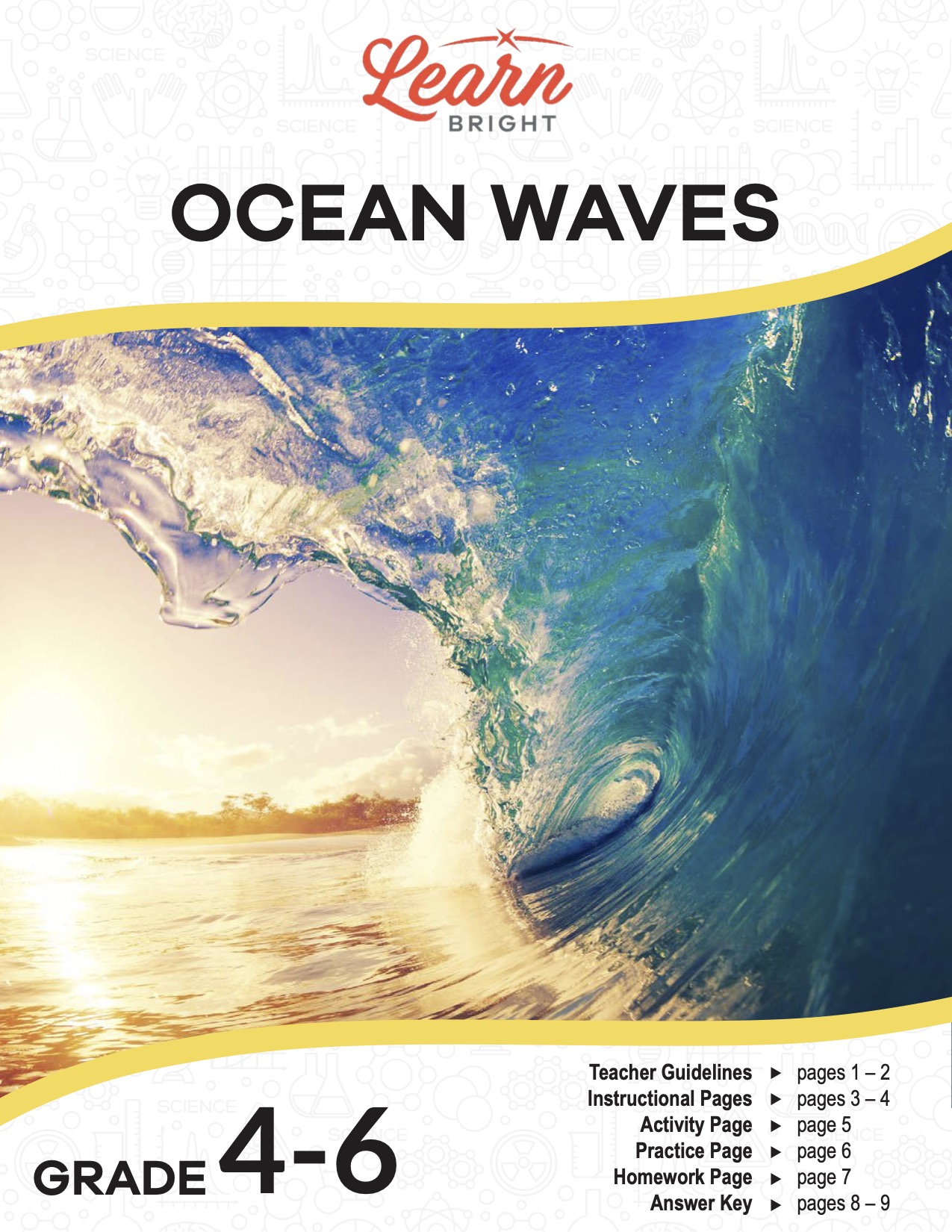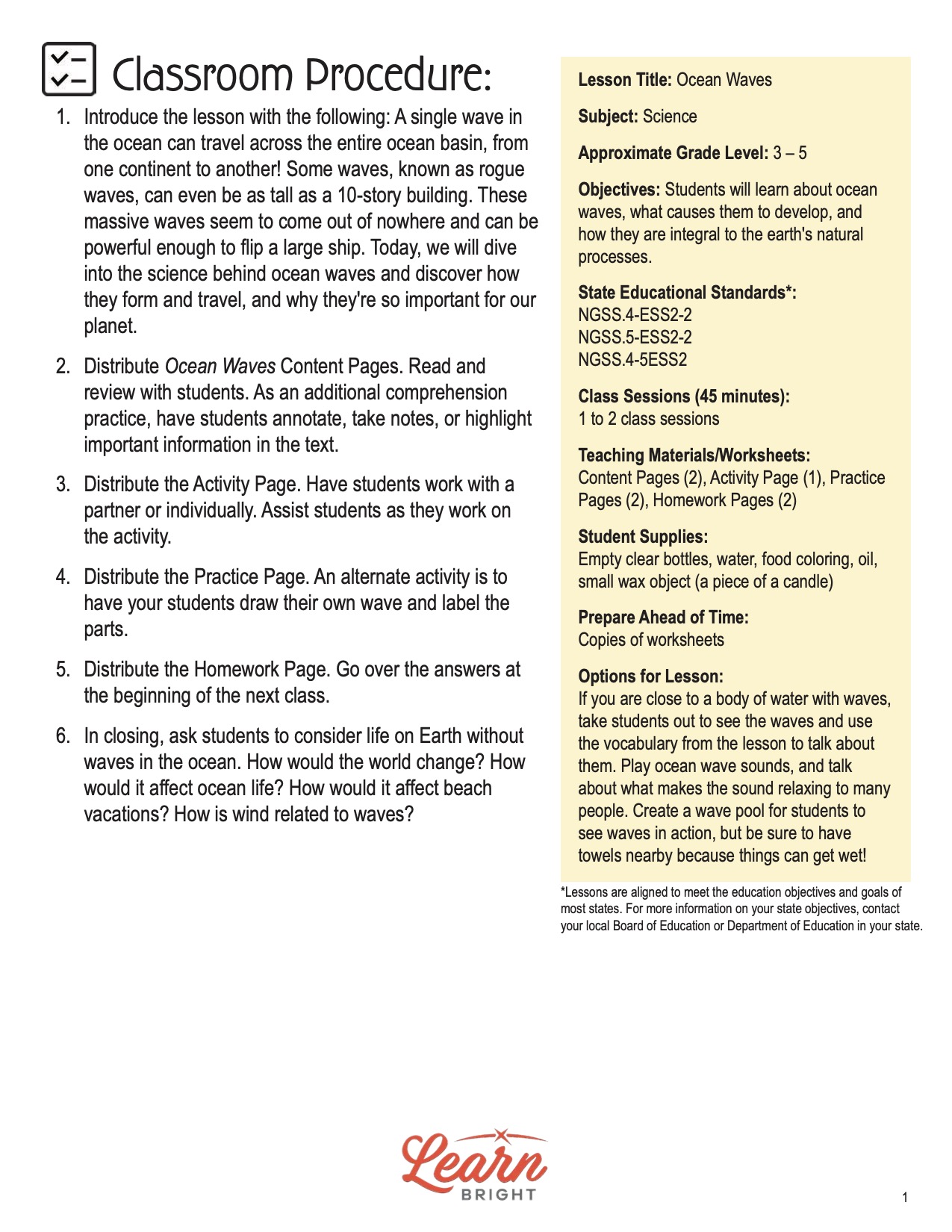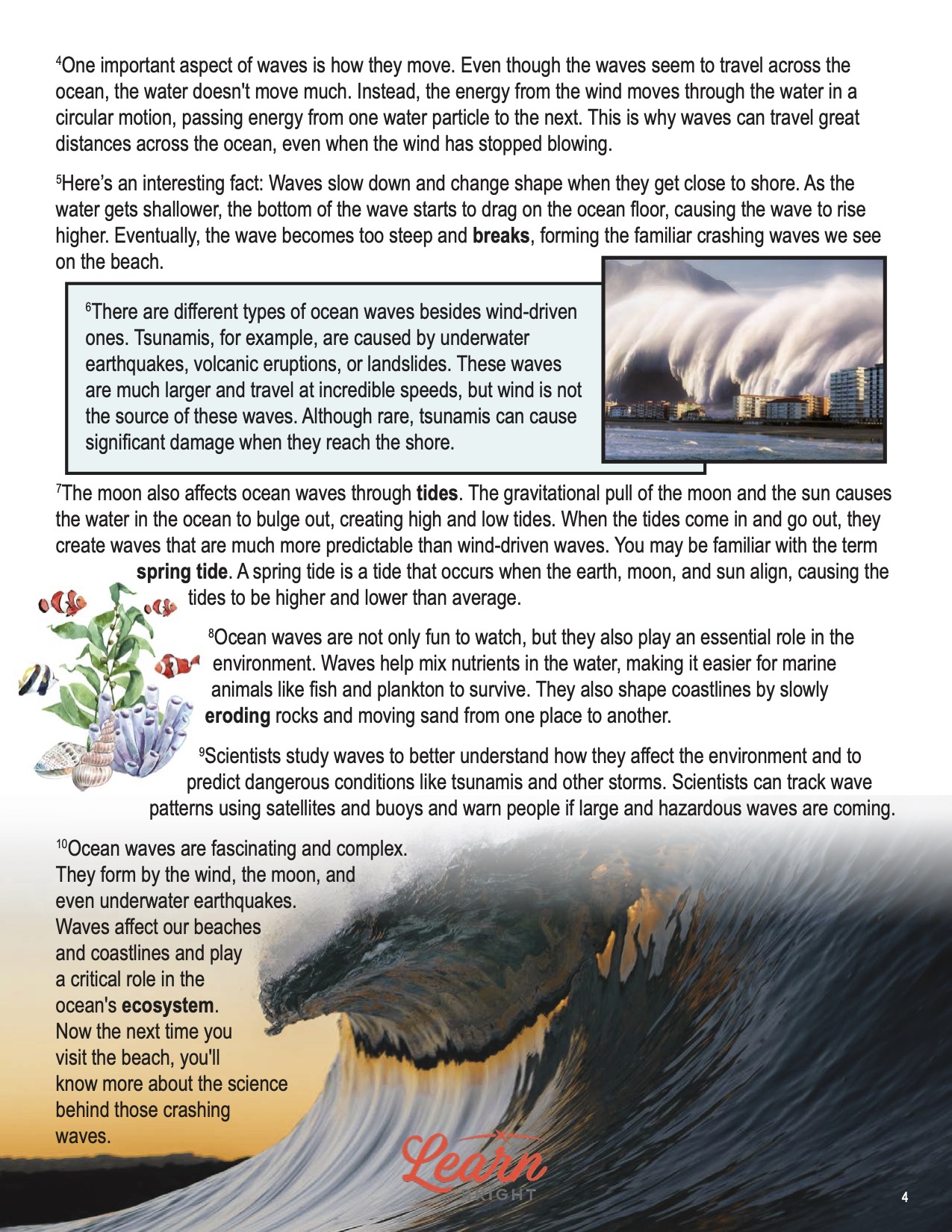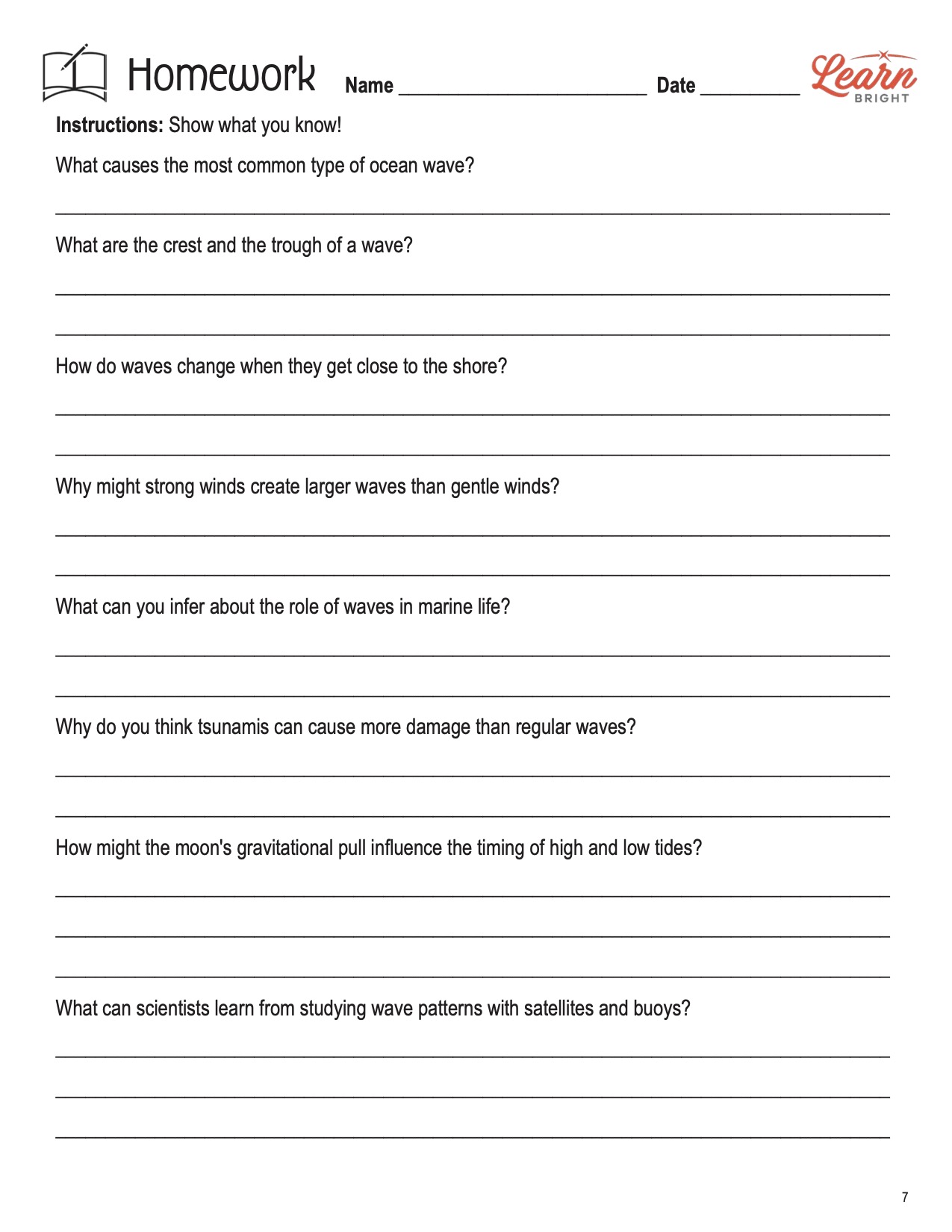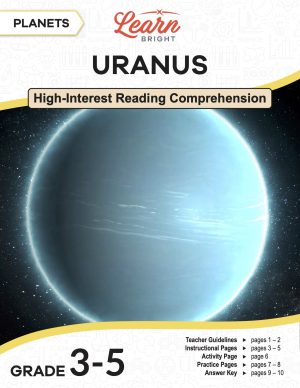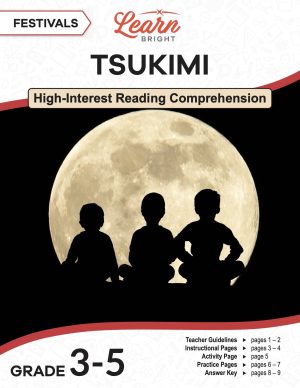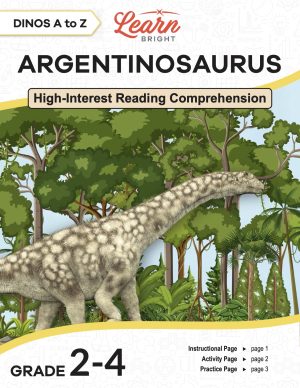Description
What our Ocean Waves lesson plan includes
Lesson Objectives and Overview—Ocean Waves explores the science behind the formation of waves in the ocean. Students will learn about ocean waves, what causes them to develop, and how they are integral to the earth’s natural processes. This lesson is for students in 4th grade, 5th grade, and 6th grade.
Classroom Procedure
Every lesson plan provides you with a classroom procedure page that outlines a step-by-step guide to follow. You do not have to follow the guide exactly. The guide helps you organize the lesson and details when to hand out worksheets. It also lists information in the yellow box that you might find useful. You will find the lesson objectives, state standards, and number of class sessions the lesson should take to complete in this area. In addition, it describes the supplies you will need as well as what and how you need to prepare beforehand. For the activity, you’ll need empty clear bottles, water, food coloring, oil, and a small wax object (a piece of a candle, for example).
Options for Lesson
The “Options for Lesson” section of the classroom procedure page offers a number of suggestions for additional ideas or activities that you could incorporate into the lesson. If you are close to a body of water with waves, take students out to see the waves and use the vocabulary from the lesson to talk about them. Play ocean wave sounds, and talk about what makes the sound relaxing to many people. Create a wave pool for students to see waves in action, but be sure to have towels nearby because things can get wet!
Teacher Notes
The paragraph on this page provides a little more information or guidance on what to expect from the lesson. It explains that the activity is a great hands-on task that will help students apply what they learned in a practical way. You can use the blank lines to record any thoughts or ideas you have as you prepare.
OCEAN WAVES LESSON PLAN CONTENT PAGES
What Are Waves?
The Ocean Waves lesson plan contains two pages of content. One of the first things you probably notice when you visit the beach is the ocean waves that crash onto the shore. These waves may seem random, but they actually follow scientific rules and patterns. Ocean waves are created mainly by the wind. Other forces, like earthquakes and the moon’s gravitational pull, can also cause waves. Let’s dive deeper into the science behind ocean waves.
Waves start when the wind blows across the surface of the ocean. It transfers some of its energy to the water as the wind blows. The stronger the wind and the longer it blows, the bigger the waves become. This process creates what scientists call wind-driven waves, the most common type of ocean wave. The lesson provides a diagram that labels different parts of an ocean wave.
Parts of a Wave
Waves have several parts, including the crest and the trough. The crest is the top of the wave, and the trough is the lowest part of a wave. The distance between two crests is called the wavelength. The height of a wave is the distance from the trough to the crest. The size and shape of waves can vary depending on wind speed, the distance the wind travels across the water, and the ocean’s depth.
One important aspect of waves is how they move. Even though the waves seem to travel across the ocean, the water doesn’t move much. Instead, the energy from the wind moves through the water in a circular motion, passing energy from one water particle to the next. This is why waves can travel great distances across the ocean, even when the wind has stopped blowing.
Here’s an interesting fact: Waves slow down and change shape when they get close to shore. As the water gets shallower, the bottom of the wave starts to drag on the ocean floor, causing the wave to rise higher. Eventually, the wave becomes too steep and breaks, forming the familiar crashing waves we see on the beach.
Waves and How They Form
There are different types of ocean waves besides wind-driven ones. Tsunamis, for example, are caused by underwater earthquakes, volcanic eruptions, or landslides. These waves are much larger and travel at incredible speeds, but wind is not the source of these waves. Although rare, tsunamis can cause significant damage when they reach the shore.
The moon also affects ocean waves through tides. The gravitational pull of the moon and the sun causes the water in the ocean to bulge out, creating high and low tides. When the tides come in and go out, they create waves that are much more predictable than wind-driven waves. You may be familiar with the term spring tide. A spring tide is a tide that occurs when the earth, moon, and sun align, causing the tides to be higher and lower than average.
Ocean waves are not only fun to watch, but they also play an essential role in the environment. Waves help mix nutrients in the water, making it easier for marine animals like fish and plankton to survive. They also shape coastlines by slowly eroding rocks and moving sand from one place to another.
Why They Are Important
Scientists study waves to better understand how they affect the environment and to predict dangerous conditions like tsunamis and other storms. Scientists can track wave patterns using satellites and buoys and warn people if large and hazardous waves are coming.
Ocean waves are fascinating and complex. They form by the wind, the moon, and even underwater earthquakes. Waves affect our beaches and coastlines and play a critical role in the ocean’s ecosystem. Now the next time you visit the beach, you’ll know more about the science behind those crashing waves.
OCEAN WAVES LESSON PLAN WORKSHEETS
The Ocean Waves lesson plan includes three worksheets: an activity worksheet, a practice worksheet, and a homework assignment. Each one will help students solidify their grasp of the material they learned throughout the lesson. You can refer to the classroom procedure guidelines to know when to hand out each worksheet.
MAKE SOME WAVES ACTIVITY WORKSHEET
Students will get to simulate waves during the activity. Using the materials you provide, they will follow the steps to create a wave within a bottle. Once they finish, they will answer questions at the bottom of the page.
LABEL THE WAVE PRACTICE WORKSHEET
The practice worksheet requires students to study a picture of a wave and label it using the vocabulary in the list at the top of the page.
OCEAN WAVES REVIEW HOMEWORK ASSIGNMENT
For the homework assignment, students will answer eight questions based on what they learned during the lesson. They will be able to find all the answers using the content pages.
Worksheet Answer Keys
There are answer keys for the practice and homework worksheets at the end of the document. Correct answers are in red to make it easy to compare them to your students’ work. If you choose to administer the lesson pages to your students via PDF, you will need to save a new file that omits these pages. Otherwise, you can simply print out the applicable pages and keep these as reference for yourself when grading assignments.

